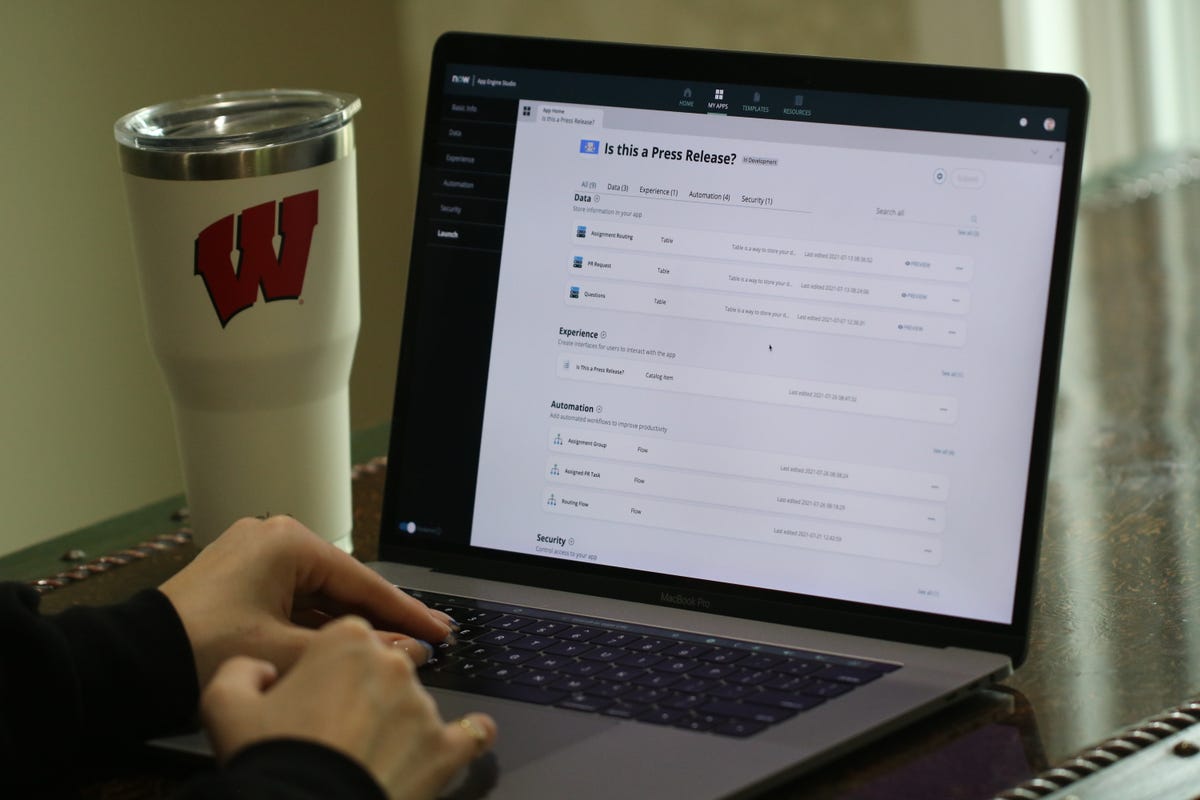For Gen Z, low-coding is about tooling and workplace culture | ZDNet
ServiceNow
Twenty-one year-old Madison DaValle understands the value of application development: In high school, she won funding through a Shark Tank-style competition to create a babysitting app.
She isn’t, however, a coder. In fact, to build her babysitting app, she had to hire a developer. As an upperclassman at the University of Wisconsin-Madison majoring in strategic communications, app development still felt out of her wheelhouse.
“I thought that that was just something that I would never be able to do unless I took coding classes or changed my major, or something like that,” DaValle said to ZDNet.
Yet as a Global Communications intern at ServiceNow this past summer, DaValle used the company’s low-code tools to build an entirely new business application, automating the somewhat tedious and time-consuming process of greenlighting press releases. She built the app as part of ServiceNow’s Citizen Developer program, using ServiceNow’s App Engine Studio.
DaValle’s experience mirrors what ServiceNow is seeing in the marketplace, according to Marcus Torres, ServiceNow’s GM of IntegrationHub and VP of Platform Product.
“What companies are really trying to do is empower people to solve their own problems,” he said.
Low-code and no-code tools are already popular in a range of industries. By the end of this year, Forrester Research predicts, 75% of development shops will use low-code platforms. And as DaValle and her peers in Gen Z enter the workforce, these platforms give them the opportunity to leverage their deep understanding of digital tools.
“For people who grew up with technology… being able to be creators themselves is an amazing thing,” Torres said.
To be sure, low-code tools aren’t about to solve the personnel problems plaguing the tech industry. While they can help accelerate app production, they can’t serve as a replacement for professional developers. Meanwhile, some surveys show younger workers are more concerned about workplace culture and flexibility than they are about the tools available to them.
DaValle’s experience, however, suggests that low-code complements a workplace culture that supports and recognizes professional growth.
“With a lot of people my age, when we talk about where we want to work, honestly, it’s not as much about what the company technically does,” she said. “It’s about, what is their culture? Are the people that you’re working with easy to get along with? Is there flexibility with your schedule? ServiceNow has been great at [offering flexibility through the pandemic]. And they allow you to really run with projects. They treat their interns like real, valuable members of their team.”

ServiceNow
DaValle decided to join ServiceNow’s Citizen Developer program after observing the cumbersome process for teams across the company that had press release requests. Employees could fill out a form and send it to a PR lead for review and approval. However, many teams would spend significant time filling out the form, only to learn that their project wasn’t newsworthy enough for a press release. Other teams would simply send their forms to the wrong person, delaying the process.
“I really saw an opportunity to use low code to create an application that would better route these press release requests and allow the PR team to filter through them appropriately,” DaValle said.
To use App Engine Studio, she took a six-hour training course that walks through the basics of low-code development. All told, building the app took her about three weeks, she said. She was able to finish it, she said, without sacrificing time on other work priorities.
Hundreds of ServiceNow employees have joined the company’s Citizen Developer program, Torres said. The program has best practices in place to ensure it doesn’t result in a glut of apps that don’t meet professional standards or serve the company’s needs. For instance, it offers “peer reviews” of apps in development, as well as “office hours” for citizen developers who need extra help. Before an app is published, there’s a team that tests it and ensures it aligns with the business.
ServiceNow plans to productize these “guardrails,” Torres said, adding other steps that App Engine customers have developed to support citizen developers.
“We’ll have an out-of-the-box citizen developer program based on all of our best practices that we’ve learned as a company, but also that our customers have told us about,” he said. The rules we’ve put in place have allowed people to keep developing and keep innovating. Sometimes they can hit a guardrail, but it keeps them on track.”
For all the latest Technology News Click Here
For the latest news and updates, follow us on Google News.
